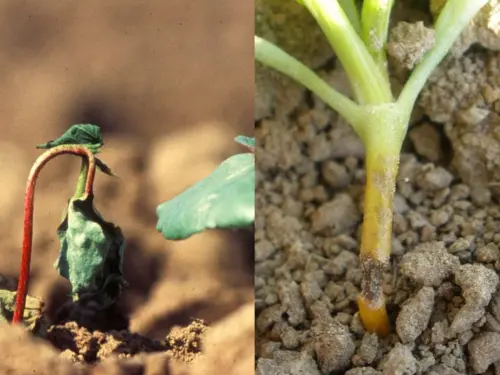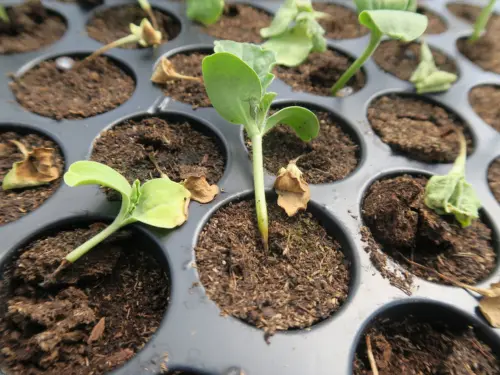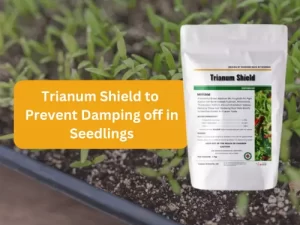Serious problems attacking young plants? Well, it is expected if you do not know how to prevent it, but if you do not know how to cure it, then you are in big trouble already. Damping off is usually a soil-borne fungal disease that kills many young plants, especially flower and vegetable plants. It usually targets the seeds and the new seedlings out there.
Damping off is basically referring to the rotting of a stem and root tissues. It usually happens at the soil line or below it. In many cases, you will see that infected plants are growing up fine by germinating, but within a few days, you will see them being mushy and water-soaked. After a certain time, these plants will collapse at the base and face unfortunate death.

Many types of fungi can cause this sort of decay of the seeds and the seedlings. It is usually caused by the species Rhizoctonia solani, Fusarium spp, Botrytis, Phytophthora, Sclerotium, and Sclerotinia. These are some of the popular culprits, but the major culprit usually is the soil fungus named pythium. When you plant old seeds in cold, wet soil temperature, you will face the damping-off issue. Cool soil, high humidity levels, and rich potting soils are a few environmental conditions that discourage the growth of the plants.
Old plants are not killed usually through damping off issues because they produce a protective layer of secondary stem tissue to form a protective barrier and disturb the penetration of the dangerous fungus. The usual symptoms of damping off are:

Cultural practices are very important to maintain the soil and plants. It is generally a very effective practice in the case of seedlings. It generally improves the survival rate of seedlings during the germination process. Cultural practice takes care of sustainable agricultural practices and does not hamper the beneficial insects or the soil in the long run. It is preferred by the farmers as a
Having sterilized soil as the growing medium of the new seeds and seedlings can always be helpful. It is important that you clean the garden and plant trays. Check for a proper drainage system in the garden before planting the seeds. If the drainage facility is not good, then there is a high chance that the seedlings can be affected. Pasteurizing potting medium can help sharply reduce the possibility of damping off among the seeds. Pasteurizing the medium helps the garden owner kill soil-borne insects, weed seeds, and pathogens. This method ensures that all the plant-damaging organisms die as soon as possible. The heat is applied for 30 minutes at 82 degrees Celsius in the pasteurizing process.
Watering is always preferable for new seeds, but the wrong methods of watering can negatively affect the seeds due to the damping off of the seeds. Proper watering should be done so that there is no excessive moisture around the field at all. Keep water in a sprayer to spray the water so that the water sprinkles everywhere evenly without heavy quantity being used anywhere.
Spacing while planting is very necessary. Many might have heard of the scientific plantation, but it is not a failed concept. Adequate spacing is necessary so that the effect of humidity is neutralized. The plants are not facing excessive shady situations, so they deliver the desired results.
There are fungicidal treatments to fight off damping in seeds. In this kind of treatment, you will usually find active ingredients like chlorothalonil, thiophanate-methyl, or copper-based fungicide options. There are labels on such products that you can follow carefully. Following this treatment but without proper ventilation can always be an issue. Catching the disease early can always act as a preventive measure for the whole crop. You can explore more fungicidal treatments that are useful in the Novobac blog section.
You can use seed treatment options with measurable formulations containing fungicides like metalaxyl, thiram, or captan. Follow the instructions of experts as far as the application rates are concerned. It helps the seeds and young seedlings from getting attacked by fungal infection. You can learn more about seed treatment solutions on this website pretty easily.
Chemical approaches are usually considered effective because of the usual short-term results they deliver. Still, if you search for biological approaches, then you will get long-term results that can lead you to have a sustainable environment without considerably affecting the crops and soil adversely.
Damping off is a severe problem in seedlings and young plants as it can cause widespread destruction without notice, sometimes leading to total crop losses. Evoked by a wide array of soil-borne pathogens, this condition leads to necrosis of caryopsis and young seedlings on and in the soil level. Yet, biocontrols particularly through the use of beneficial microorganisms provide a viable option to reduce such diseases. Novobac has an incredible solution; Trianum Shield which is a biological fungicide. This is derived from the fungus Trichoderma harzianum which is effective in suppressing damping-off.

TRIANUM SHIELD based on Trichoderma harzianum belongs to the fungus group of Trichoderma species which provides a whole spectrum of biological control of phytopathogens and root pathogens. Such a product creates a symbiosis with plants, in which Trichoderma species will colonize on the root system, and it gives an antagonism towards soil-borne diseases. It functions through various modes of action which include colonizing their niche thereby competing with harmful pathogens for space and resources, parasitizing them and causing their cell walls to collapse as the hormones within kill them. Not only this helps plant roots to protect them from pathogenic fungi, but strengthens and improves the root system, improves the nutrient absorption ability of the plant and strengthens the plant tolerance to stress, which contributes in increasing the yield.
The essence of TRIANUM SHIELD is Trichoderma harzianum and it is majorly involved in promoting seedlings’ health by interacting with mycorrhizal fungi. The mycorrhizae are beneficial, as they have a mutualistic association with the plant roots that extend the root system increasing the plant’s ability to absorb water and nutrients. The effect of Trichoderma harzianum adds to this relationship resulting in strong seedlings which are more healthy and are capable of surviving damping off and other soil borne diseases.
For optimal results in preventing damping off, TRIANUM SHIELD should be applied at a dosage of 3 kgs per acre to the crop as early as possible, where early season seed rot and seedling diseases are expected. To extend root protection for season-long control, a reapplication after a 10-12 week period is recommended. It can be used on mature crops as well as seeds, transplants, bulbs, cuttings, and grafts, applied through spraying, drip-irrigation, or soil drenching. Its effectiveness spans a wide temperature range (10℃-34℃) and pH levels between 4-10, making it versatile for various growing conditions.

Biological approaches to plant disease management, such as the use of TRIANUM SHIELD, offer several advantages over chemical fungicides. They are sustainable, leaving no harmful residues in the soil or on the crops, thus supporting organic farming practices. Biological controls work by enhancing the natural defense mechanisms of plants and promoting a healthy soil microbiome, which can lead to long-term agricultural sustainability. Furthermore, they reduce the risk of pathogens developing resistance, a common issue with chemical treatments.
Using biological fungicides like Trianum Shield from Novobac can help you prevent damping off seedlings without impacting the environment at all. It does not even leave residue, unlike the chemical fungicides that affect the plants in future harvesting periods. It helps the gardeners to have good control over the resistance management. Healthy seedlings mean amazing plants, a great garden, and a beautiful planet to live in a sustainable fashion.
Cutworms in gardens are a major menace to all..
As a farmer,I inspect my fields daily to monitor..
It all started with a worried farmer named Mr...

Leave a Reply